ZHABDRUNG NGAWANG NAMGYAL IN NGAGCHANG CLOAK
Statues of Zhabdrung Ngawang Namgyal depicted in the ritual ngagchang (སྔགས་འཆང) cloak are rare in Bhutanese temples. However, his image clad in this attire frequently appears in the murals of gönkhangs—shrines dedicated to the three chief protector deities: Yeshey Gönpo, Paldhen Lhamo, and Leygön Jaro Dongchen. In these sacred spaces, the ngagchang cloak is an integral art of his representation.
The image of Zhabdrung in the ngagchang cloak holds profound historical and spiritual significance, dating back to the era when Bhutan faced repeated invasions by Tibetan forces. During those turbulent times, ritual dances and torma offerings were performed with the Zhabdrung adorned in ngagchang, invoking protective deities to ensure victory and safeguard Bhutanese warriors.
One of the most storied moments occurred during the siege of Punakha Dzong by powerful Tibetan forces. It is said that Zhabdrung Rinpoche, visible to the enemy encamped across the river, conducted a powerful religious offering. Wearing ngagchang cloak, he threw a replica of the sacred Rangjung Kharsapani—a self-arisen image of Avalokiteshvara said to have emerged from the first vertebra of Tsangpa Gyarey—along with other sacred relics into the Mochhu River. This act was intended to deceive the Tibetan army, leading them to believe the relics were lost and prompting their retreat.
This dramatic gesture is commemorated to this day through a ceremonial reenactment. While replicas of sacred relics are no longer used, oranges are cast into the river, and people rush into the water to retrieve them, symbolizing blessings and protection.
The statue uploaded here was offered to Jarogang Lhakhang by former Member of Parliament, Dawa, in recognition of the temple’s spiritual and historical importance. It is at this sacred site that Leygön Jaro Dongcheng is believed to have physically appeared before Zhabdrung, reassuring to defeat the Tibetan invaders. According to sources, Zhabdrung nearly departed for present-day India, had the deity not appeared physically to reaffirm their commitment. Subsequently, the place came to be known as Jaro-gang, inheriting its name from the divine appearance of Leygön Jaro Dongchen.



Comments
Post a Comment